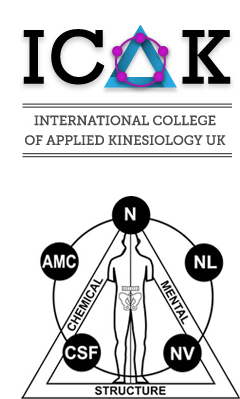|
The method of AK is primarily concerned with neuromuscular function and how it relates to the regulation of structural, chemical and mental physiology. It uses the principle that the body is a self-maintaining, self-correcting mechanism.
|
A Brief HistoryThe use of manual muscle testing to evaluate body function was introduced by George H. Goodheart Jr D.C. (Doctor of Chiropractic) in 1964. Since then, research into and knowledge of AK has expanded considerably, providing many additional dimensions to the diagnosis of bodily dysfunction.
Even in the early days of AK, it was apparent how the use of many basic treatment methods in Osteopathy, Chiropractic, Acupuncture and Homeopathy produced immediate improved neuromuscular function which could be directly measured using manual muscle testing. The development of AK has resulted in the modification of these techniques along with the introduction of some new procedures unique to AK.
Aims of Applied Kinesiology
To restore the balance of structural, chemical and mental factors which together unite to form the 'triad of health'.  When a person has ill health, at least one of these factors is involved and often two, or all three. The principle of Applied Kinesiology is to assess all three areas and treat those that have been disrupted.
When a person has ill health, at least one of these factors is involved and often two, or all three. The principle of Applied Kinesiology is to assess all three areas and treat those that have been disrupted.
An example of this is a person suffering with a long-term intestinal irritation. Nutritional balance in the body will be severely disrupted due to malabsorption problems and possibly long-term use of antibiotics. Low back pain will be evident due to the dual nerve supply to the low back and intestine and there will be stress-related elements that further exacerbate symptoms.
It is imperative in the treatment of this person that all three aspects are evaluated in order to restore the balance of the 'triad of health', and help the person return to complete wellness.
What to Expect when Going for a TreatmentThe practitioner will take a full and detailed history. Above all, the patient is given time to talk, and the practitioner will be concerned with establishing a complete picture in order to understand the problem as fully as possible. The Applied Kinesiology practitioner will perform a wide variety of muscle tests on the patient in order to establish areas of dysfunction.
AK gives a detailed insight into body function but it must be emphasised that it is used in conjunction with standard diagnostic tests whenever relevant - X rays, physical diagnosis, history, blood tests etc. AK examination enhances standard diagnosis and is enhanced by standard diagnosis.
The great advantage of AK is that the practitioner no longer needs to rely entirely on chemicals or invasive technology to treat the patient. AK provides a system whereby the practitioner works with the patient and the patient is able to be actively involved in their treatment and has an immediate source of feedback through muscle testing. In this way, the patient is able to adopt a much greater sense of responsibility towards his illness and can have a greater awareness of his body's dysfunction.
When visiting an AK practitioner, expect to be involved. They will test for basic mechanical defects; the possible connection of visceral dysfunction (that is, the function of the associated gland or organ); stress levels in the body; and, where relevant, cranial and pelvic distortion and toxicity/allergy problems. Treatment may involve any combination of manipulative work, guidance in self-treatment, nutritional support, homeopathic remedies and treatment to aid stress-related problems.
What does an AK Practitioner Treat ?AK may be able to help with basic structural problems for which a person may visit a healthcare practitioner e.g.
- low back pain
- sciatica
- headaches + migraines
- postural abnormalities
- disc injuries
- nerve root irritation
- acute onset sports injuries
- stress related disorders
In addition, an AK practitioner may be able to address many other functional and systemic disorders from which people increasingly suffer in modern day society e.g.
- allergies, including asthma, eczema and hayfever
- recurrent ear, nose , and throat infections
- hormone related disorders
- symptoms of PMT and menopause
- irritable bowel syndrome
- post viral syndrome/ME
- food intolerances
- sleep pattern disorders
- childhood disorders including dyslexia and behavioural problems
What will an AK treatment Cost?Expect to pay between £70-£100 per session, with an Applied Kinesiology practitioner, depending on qualifications and location. Many practitioners are covered by private healthcare / medical insurance.
How many treatments will be required? Applied Kinesiology is used to treat individuals rather than diseases, and so each treatment programme is unique for that particular person. After the first couple of sessions, the practitioner should be able to estimate the duration of treatment needed to help resolve your problem.







